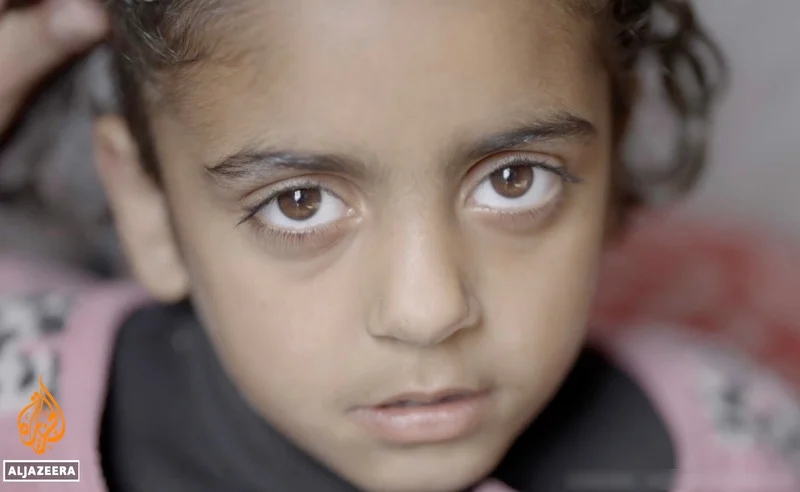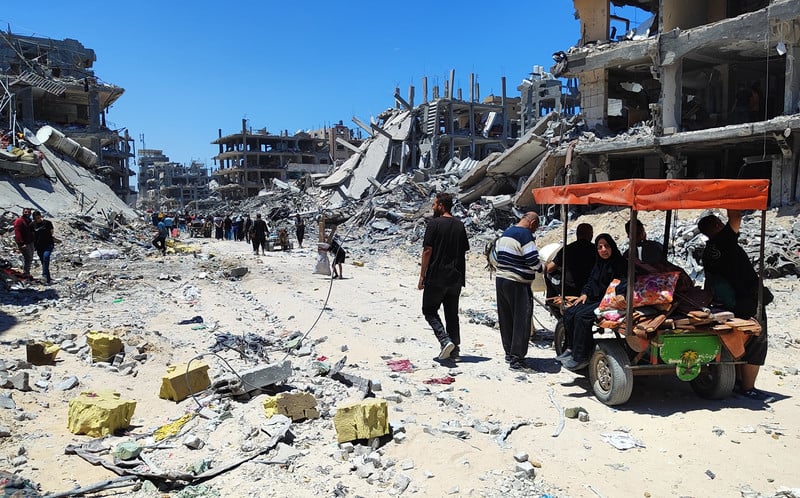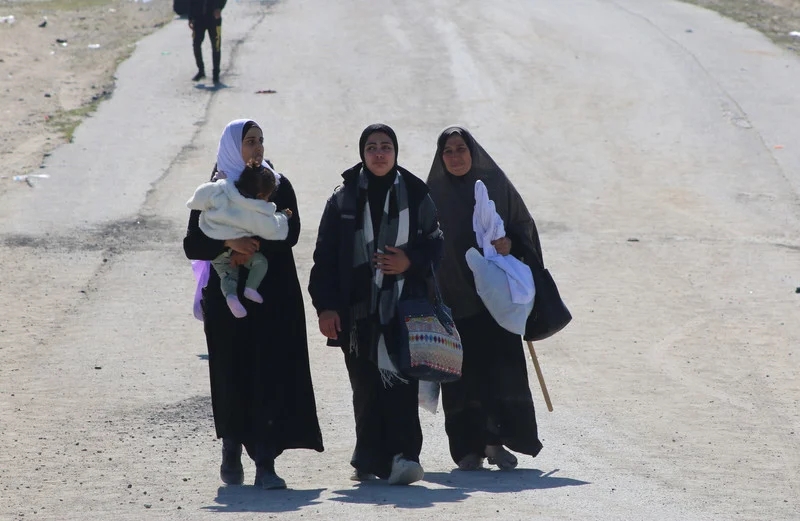New film gives a harrowing glimpse of Gaza’s endless night
Asa Winstanley, Electronic Intifada, Jun 21 2024

The head of Amnesty International says that Israel’s unprecedented violence in Gaza has proven international law to be “frankly useless.” Amnesty’s secretary general Agnès Callamard told Al Jazeera:
We are really as close to the abyss as we have ever been.
Callamard’s comments feature in a new film titled The Night Won’t End, an uncompromising examination of Israeli war crimes during the genocide in Gaza. The new documentary is part of the Qatar-based channel’s Fault Lines series. The film examines the genocide through the lens of four Palestinian families in Gaza and the massacres Israel has carried out against them. You can watch the full film in the video embedded below. One of the families is that of Hind Rajab, the 6-year-old Palestinian girl murdered by Israeli troops in January while she was on the phone to the Palestine Red Crescent Society desperately calling for help. Trapped in a car surrounded by the bodies of her dead family, Hind was the sole survivor of an Israeli massacre. The family were fleeing their Gaza City home.
The film includes harrowing audio of that phone call as well as interviews with Hind’s mother and Red Crescent workers as it details the doomed efforts to save the girl while she was pinned down in the car. After detailed coordination with Israeli occupation authorities, they sent paramedics to evacuate the surviving girl. Despite traveling along the exact route dictated by the Israeli military, the two paramedics were instantly shot dead by the Israeli soldiers when they arrived on the scene. The bodies of Yousif Zeino and Ahmad al-Madhoun were only found two weeks later, along with the bodies of Hind and her six relatives. Hind’s mother Wissam Hamada says in the film that she never had any faith in international law in the first place. Hamada says:
I never felt that international laws or international organizations ever did anything for Gaza. It’s just ink on paper. They didn’t protect paramedics, journalists, children or civilians. Hind, Layan, my uncle, his wife and children were executed in cold blood.
Hind’s killing caused outrage around the world. In April student activists at Columbia University in New York renamed the building they occupied on campus“Hind’s Hall.” The hip-hop artist Macklemore later released a song of the same name. Speaking to Al Jazeera, Nisreen Qawas from the Palestine Red Crescent Society headquarters in Ramallah also relives the trauma of that day. Sshe says:
What makes it more difficult for me: Is it only Hind? Is there another one thousand Hind’s story? Ten thousand Hind’s stories? That did not have a name and a story on the TV, on the news, was not spread?
Israel’s genocidal war against the population of the Gaza Strip has so far killed more than 37k people since Oct 7 2023, a number thought to be a significant underestimate due to the large number of bodies that remain trapped under the rubble. According to the film:
By the end of 2023, more journalists and aid workers had been killed in Gaza than in any other conflict of the last few decades.
Amnesty’s Callamard has given similar warnings about the dire state of international law before. In April she told Democracy Now! that “the international system is on the brink of collapse” due to the refusal by the US and others to hold Israel accountable for its crimes. In The Night Won’t End, Al Jazeera journalist Sharif Abdel Kouddous also says that Israel’s assault on Gaza has “upended the system of international laws” created since 1945. Amnesty’s Callamard says:
The rules that were supposed to bind us together to prevent the worst from happening, those rules are no longer applicable. Everything we created after WW2: that’s up for rewriting. And trust me, it will not just be the US and their allies who are gonna do that. They have opened the door to hell.
Executive producer and co-writer of the film Laila al-Arian will speak to The Electronic Intifada livestream on Wednesday next week.
Gaza, where have you gone?
Malak Hijazi, Electronic Intifada, Jun 21 2024

Growing up amid wars has meant constant upheaval and fear. When Israel attacked Gaza in Dec 2008, I was 8. I sought refuge from the bombs by hiding in my closet and under my bed. That ingrained a deep claustrophobia in me. When Israel waged another war against Gaza in Jul-Aug 2014, I was 15. My trauma manifested itself in an eating disorder. The current genocidal war in Gaza surpasses all prior horrors. The devastation is unimaginable. Most of the places I once frequented are now either gone or repurposed. From my childhood home reduced to debris to the kindergarten, school and university razed by Israeli forces, the destruction is pervasive. All the places where I spent time with friends have been bombed, including our favorite resort, book shop and restaurant. My grandparents’ house is partially destroyed. Even the photo of my grandparents’ wedding, which had been hanging on the wall for more than 50 years, has bullet holes in it. All the photos on the wall were shot at. It was as if an Israeli soldier imagined himself in a video game.
The loss feels even greater when I think of how those places shaped who I am. They provided a backdrop for my childhood and a sense of belonging. Now that they are destroyed, it feels as if a part of my identity has been erased, leaving behind only the intangible echoes of what once was. The landscape of my childhood, once full of life, is now a series of fragmented memories of places that no longer exist. When Israel ordered a mass evacuation of northern Gaza during October, many people living in Jabaliya refugee camp and its environs refused to leave. The area, therefore, remained densely populated. Like other parts of the Gaza Strip, Jabaliya camp endured intense Israeli bombardment. A massacre in the camp on 31 October resulted in a huge number of civilian deaths. Dropping at least six bombs from the air, the Israeli military caused extensive destruction. A massive crater was left in the heart of the camp. The impact of this crime was deeply personal for me. Many of Jabaliya’s residents are originally from Deir Suneid, my family’s village in historic Palestine. Deir Suneid was ethnically cleansed by the Israeli army in Nov 1948. More than 100 people who were originally from Deir Suneid have been killed during the current genocide in Gaza. About half of them were my relatives. These were people I had known from various gatherings.
Despite the devastation, signs of resilience persisted. Remarkably, Jabaliya’s market continued to operate, with shop owners persevering to sell goods amid the war. Jabaliya’s residents also tended to their lands, salvaging whatever crops remained, such as mallow and lemons. At a time of famine and destruction, their resourcefulness knew no bounds. They made kaak (cookies) using animal feed flour. Surprisingly, the kaak tasted delicious. They made chips from corn flour. At a time when vegetables were scarce in the market, I enjoyed the most incredible falafel. Due to the shortage of fuel, civil defense teams struggled to function effectively. Consequently, when houses were bombed, the residents of the camp came together to search for the missing beneath the rubble, utilizing basic tools and their bare hands. Many people shared their solar panels with their neighbors. They sent food to each other in the darkest days of famine. They helped each other to carry containers of water. They erected tents on the rubble of their destroyed homes and made do with what they had. Jabaliya remained bustling, a testament to the strength and unity of its people. People marveled at how despite all the destruction in Jabaliya, its market remained crowded. My mother said:
God bless Jabaliya! God only knows what the Israelis plan to do next time. The Israelis hate lively places because they show it is possible to recover.
During this current war, people have not become optimistic when life has returned to a specific area. They know that the Israelis are likely to invade again. That has been evident from Gaza City. After withdrawing from the neighborhoods of al-Rimal and al-Zaytoun, the Israelis reinvaded them. They did the same with al-Shifa, Gaza’s largest hospital. And they did the same with Jabaliya. Months after withdrawing from Jabaliya last year, the Israeli military reinvaded it last month. The stated objective of Israel’s invasions is to defeat Hamas. Of course, that is not true. The real reason is that people in Jabaliya had begun to recover. And the Israelis do not want that to happen. By “recovering,” I mean that people tried to rebuild or clean up what the Israelis had destroyed. Despite the destruction, places started to thrive. Some people began to feel a semblance of stability. Whenever such recovery starts, the Israeli army returns, destroys and kills again, making life impossible. It felt like we were going around in circles. People who were relieved that their houses were damaged rather than destroyed during the first invasion faced the horrible prospect that their homes would not withstand a second or third invasion.
Israel wants all of us to be homeless. Jabaliya had already been devastated last year. So what was the point of inflicting more destruction on it in May 2024? The answer was to erase landmarks in and other features of Jabaliya so that its residents could no longer recognize them. My father received numerous calls from relatives expressing their confusion over the whereabouts of their homes. The term “destruction” fails to capture what Israel has done. My father headed towards northern Gaza but ultimately decided against visiting Jabaliya. He was unable to bear witness to how his childhood surroundings had been transformed into piles of rubble. He even avoided viewing photos on social media so that he could spare himself the heartache. Not a single place in Jabaliya was left undamaged during Israel’s May invasion. It feels like Israel soldiers compete to see who can cause the most harm. Any possibility of recovery has been leveled to the ground. Huge numbers of houses were demolished. The once vibrant market is now a ghost town. Its shops have been wiped out. Jabaliya camp used to be the most lively place in northern Gaza. Now to all intents and purposes it no longer exists. The infrastructure on which the camp relied has also been devastated. That includes the generators in the two local hospitals.
I have spent most of my life in Jabaliya. I knew it intimately. I remember the corner of my childhood house that I mischievously painted with watercolors, only to be scolded by my mother. I remember where I used to try and hide school reports with bad grades, hoping that my mother would not notice them. I remember how I ate strawberries on the balcony as a 7-year-old, while chatting to the girl next door. I remember going with my mother to the Jabaliya camp market. I remember begging for ice cream from Abu Zaytoun’s shop, as my mother carried bags filled with things she had bought. The ice cream machine seemed magical. It could shape perfect vanilla and chocolate towers. I remember the hum of the machine. It breaks my heart to know it has now been destroyed. I remember the shop where we would buy new clothes for Eid and the one where I sat by the entrance begging my mother for a toy horse. They are now reduced to ruins. The route to my childhood friend’s home remains etched in my mind, though it was demolished by the occupation forces. She and her family were killed last year. The roads once filled with the sounds of students leaving their schools are now in a terrible state. The schools had been turned into shelters during the war. Most of them are destroyed or badly damaged. So many memories are etched in my mind. But the physical spaces associated with those memories are gone. It makes me wonder, what is the importance of all these memories if there is no physical evidence left to anchor them? What should I do with the mental maps that remain of these places?
When we say “this is my place,” we’re not just referring to a physical location. We are referring to something bigger within a cohesive social framework. Disruptions to our sense of place can have far-reaching implications for our personal identity and well-being. A home serves as more than just a shelter. It symbolizes safety, dignity and pride. It’s where families live, dream, celebrate and mourn. Furthermore, it provides a foundation for the growth, development and education of children and for the security of parents and grandparents. The systematic destruction of homes in modern warfare has profound human consequences. The geographer J Douglas Porteous coined the term “domicide” in 1998. It is defined as the “planned, deliberate destruction of someone’s home, causing suffering to the dweller.” Domicide is violence that not only results in physical displacement but also the erosion of dignity, memory and identity. Domicide disrupts daily life, transforming once familiar places into alien landscapes. Parts of Gaza now feel unfamiliar, as though they no longer recognize me. Despite my disorientation, I am pushing forward. I am clinging to the mental maps of places I once knew. I confess that I am unsure of how relevant these mental maps are in this new reality. But I am determined to carve out a path amid the destruction. I am holding onto the memories of the erased landmarks, longing for their eventual return. Beloved Gaza, where have you gone?
A six month journey to safety
Asmaa Habib, Electronic Intifada, Jun 21 2024

Alaa, 31, used to live in Gaza, when it was merely a besieged city weighed down by isolation. She married an Egyptian, Ahmed, and traveled with him to Egypt, spending 10 years without seeing her family in Gaza due to financial constraints. Alaa and her husband spent much of their money trying to conceive, undergoing seven expensive in vitro fertilization procedures, all of which failed. But God had plans for Alaa’s happiness. On the eighth attempt, she gave birth to twins, Hassan and Hussein. Alaa’s and Ahmed’s joy was indescribable, and they wanted to share this happiness with their families. Alaa decided to travel back to Gaza to visit her family. Alaa embarked on the torturous journey with her two-month-old twins through the Rafah border crossing. She arrived in Gaza on Oct 5. She had not informed her family, intending to surprise them. She found the home only with some difficulty. After ten years, the neighborhood had been transformed, with new high-rise buildings and a beautiful garden.
Alaa was warmly welcomed by her family. Her father nearly fainted, her mother cried with joy, and her sister screamed loudly in delight. But their joy was short-lived. On Oct 7, the Israeli military attacked Gaza. The family at first decided to stay in their home despite the relentless shelling. Alaa’s father preferred to stay in Gaza and did not heed the Israeli army’s calls to evacuate to the south, as he did not know anyone there who could take them all in. Alaa had to move from house to house seeking safety, eventually deciding to stay in al-Shifa hospital. It was not a permanent refuge. Days passed with difficulty as hunger and a lack of milk and diapers for her twins along with exorbitant prices took their toll. In Egypt, Alaa’s husband tried in vain to get the family out. Alaa, meanwhile, endured much anguish trying to provide food for her twins and herself. Her family was in the same position and in March, when the situation got particularly acute, Alaa’s brother, Muhammad, decided to go to Kuwait roundabout to get flour for his sister and her children. He was shot by the army and died trying to bring a bag of flour to the family. Later that month, after six months of suffering for Alaa and their babies, Ahmed managed to get the names of his immediate family members on the travel list of the Egyptian Ministry of Foreign Affairs. The journey to the Rafah crossing in Gaza’s south was fraught with danger, but Alaa knew she had no other choice. She set out to walk south, a nine-hour journey under the scorching sun, pulling her children in a cart over rough, sandy roads with deep holes.
At one point, she stumbled into a hole and could not lift the cart out. It was not safe to stop for long, so Alaa left the cart and carried Hassan and Hussein on her shoulders, her frail body moving through sheer force of determination. On the way, she saw horrifying scenes of dead people and animals on the roadside and bodies being eaten by cats and dogs. Her heart was wrenched with pain. When Alaa reached the army checkpoint, she faced new challenges. The soldiers initially refused to let her pass. But after Alaa persisted and showed the Egyptian passports of her children, they allowed her through. Alaa continued walking until she finally reached the crossing, having walked some 35 km from Gaza to Rafah. When she crossed the border, she was exhausted and tired, but her heart was filled with hope. She reached her husband after a strenuous journey and embraced him. He did not recognize his children at first, as the babies he had left at 2 months old were now crawling and talking. Alaa and her twins survived, but her heart remained divided between the joy of their survival and the sorrow for her elderly father and sick mother left behind in Gaza.